
Hardened mud playa and sand dunes, dawn, Mesquite dunes.
Location: Stovepipe Wells, Death Valley National Park, California
Image ID: 28679
Location: Stovepipe Wells, Death Valley National Park, California
Image ID: 28679
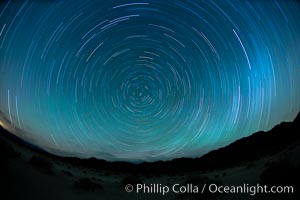
Star trails, rotating around the North Star (Polaris), seen from Death Valley.
Location: Milky Way Galaxy, The Universe
Image ID: 25270
Location: Milky Way Galaxy, The Universe
Image ID: 25270

Lonely road, Death Valley.
Location: Badwater, Death Valley National Park, California
Image ID: 25252
Location: Badwater, Death Valley National Park, California
Image ID: 25252

Salt polygons. After winter flooding, the salt on the Badwater Basin playa dries into geometric polygonal shapes.
Location: Badwater, Death Valley National Park, California
Image ID: 25254
Location: Badwater, Death Valley National Park, California
Image ID: 25254

West Side Road cuts across the Badwater Basin.
Location: Badwater, Death Valley National Park, California
Image ID: 25261
Location: Badwater, Death Valley National Park, California
Image ID: 25261

Eureka Dunes. The Eureka Valley Sand Dunes are California's tallest sand dunes, and one of the tallest in the United States. Rising 680' above the floor of the Eureka Valley, the Eureka sand dunes are home to several endangered species, as well as "singing sand" that makes strange sounds when it shifts. Located in the remote northern portion of Death Valley National Park, the Eureka Dunes see very few visitors.
Location: Eureka Dunes, Death Valley National Park, California
Image ID: 25274
Location: Eureka Dunes, Death Valley National Park, California
Image ID: 25274

Zabriskie Point, sunrise. Manly Beacon rises in the center of an eroded, curiously banded area of sedimentary rock, with the Panamint Mountains visible in the distance.
Location: Zabriskie Point, Death Valley National Park, California
Image ID: 15585
Location: Zabriskie Point, Death Valley National Park, California
Image ID: 15585

Eroded hillsides near Zabriskie Point and Gower Wash.
Location: Zabriskie Point, Death Valley National Park, California
Image ID: 25255
Location: Zabriskie Point, Death Valley National Park, California
Image ID: 25255

Eureka Dunes. The Eureka Valley Sand Dunes are California's tallest sand dunes, and one of the tallest in the United States. Rising 680' above the floor of the Eureka Valley, the Eureka sand dunes are home to several endangered species, as well as "singing sand" that makes strange sounds when it shifts. Located in the remote northern portion of Death Valley National Park, the Eureka Dunes see very few visitors.
Location: Eureka Dunes, Death Valley National Park, California
Image ID: 25272
Location: Eureka Dunes, Death Valley National Park, California
Image ID: 25272

Eureka Dunes. The Eureka Valley Sand Dunes are California's tallest sand dunes, and one of the tallest in the United States. Rising 680' above the floor of the Eureka Valley, the Eureka sand dunes are home to several endangered species, as well as "singing sand" that makes strange sounds when it shifts. Located in the remote northern portion of Death Valley National Park, the Eureka Dunes see very few visitors.
Location: Eureka Dunes, Death Valley National Park, California
Image ID: 25273
Location: Eureka Dunes, Death Valley National Park, California
Image ID: 25273
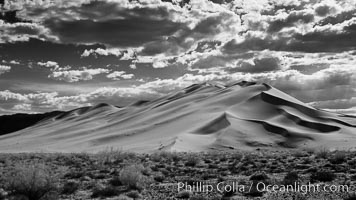
Eureka Dunes. The Eureka Dunes are California's tallest sand dunes, and one of the tallest in the United States. Rising 680' above the floor of the Eureka Valley, the Eureka sand dunes are home to several endangered species, as well as "singing sand" that makes strange sounds when it shifts.
Location: Eureka Dunes, Death Valley National Park, California
Image ID: 25251
Location: Eureka Dunes, Death Valley National Park, California
Image ID: 25251

Arid and barren mud flats, dried mud, with the tall Eureka Dunes in the distance.
Location: Eureka Valley, Death Valley National Park, California
Image ID: 25281
Location: Eureka Valley, Death Valley National Park, California
Image ID: 25281

Sunrise at Zabriskie Point, Manly Beacon is lit by the morning sun while dark clouds lie on the horizon.
Location: Zabriskie Point, Death Valley National Park, California
Image ID: 25257
Location: Zabriskie Point, Death Valley National Park, California
Image ID: 25257
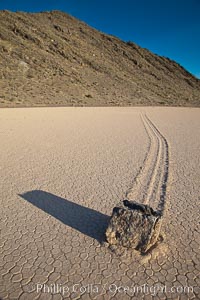
A sliding rock of the Racetrack Playa. The sliding rocks, or sailing stones, move across the mud flats of the Racetrack Playa, leaving trails behind in the mud. The explanation for their movement is not known with certainty, but many believe wind pushes the rocks over wet and perhaps icy mud in winter.
Location: Racetrack Playa, Death Valley National Park, California
Image ID: 25243
Location: Racetrack Playa, Death Valley National Park, California
Image ID: 25243
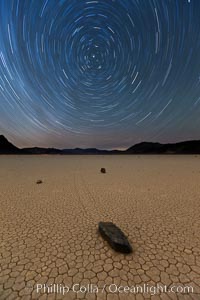
Racetrack sailing stone and star trails. A sliding rock of the Racetrack Playa. The sliding rocks, or sailing stones, move across the mud flats of the Racetrack Playa, leaving trails behind in the mud. The explanation for their movement is not known with certainty, but many believe wind pushes the rocks over wet and perhaps icy mud in winter.
Location: Racetrack Playa, Death Valley National Park, California
Image ID: 27668
Location: Racetrack Playa, Death Valley National Park, California
Image ID: 27668

Dried tree and barren, arid mud flats, Eureka Valley.
Location: Eureka Valley, Death Valley National Park, California
Image ID: 25337
Location: Eureka Valley, Death Valley National Park, California
Image ID: 25337

Volcanic debris, small lava rocks scattered about the Eureka Valley.
Location: Eureka Valley, Death Valley National Park, California
Image ID: 25340
Location: Eureka Valley, Death Valley National Park, California
Image ID: 25340
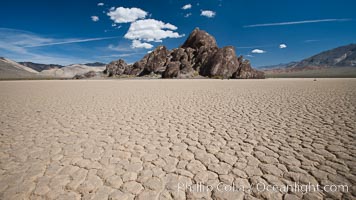
The Grandstand, standing above dried mud flats, on the Racetrack Playa in Death Valley.
Location: Racetrack Playa, Death Valley National Park, California
Image ID: 25313
Location: Racetrack Playa, Death Valley National Park, California
Image ID: 25313

Eroded hillsides near Zabriskie Point and Gower Wash.
Location: Zabriskie Point, Death Valley National Park, California
Image ID: 25295
Location: Zabriskie Point, Death Valley National Park, California
Image ID: 25295

Eroded hillsides near Zabriskie Point and Gower Wash.
Location: Zabriskie Point, Death Valley National Park, California
Image ID: 25296
Location: Zabriskie Point, Death Valley National Park, California
Image ID: 25296
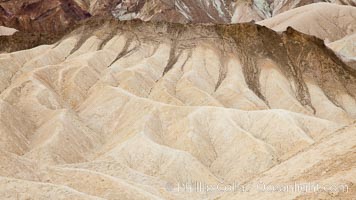
Eroded hillsides near Zabriskie Point and Gower Wash.
Location: Zabriskie Point, Death Valley National Park, California
Image ID: 25297
Location: Zabriskie Point, Death Valley National Park, California
Image ID: 25297

Dawn, Zabriskie Point.
Location: Zabriskie Point, Death Valley National Park, California
Image ID: 25298
Location: Zabriskie Point, Death Valley National Park, California
Image ID: 25298
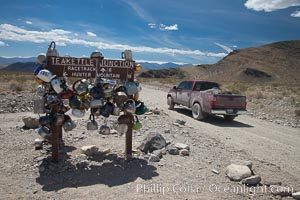
Teakettle Junction, on the notorious road to the Racetrack Playa.
Location: Death Valley National Park, California
Image ID: 25335
Location: Death Valley National Park, California
Image ID: 25335

Sunset on the Last Chance Mountain Range, seen from Eureka Valley Sand Dunes.
Location: Eureka Dunes, Death Valley National Park, California
Image ID: 25351
Location: Eureka Dunes, Death Valley National Park, California
Image ID: 25351
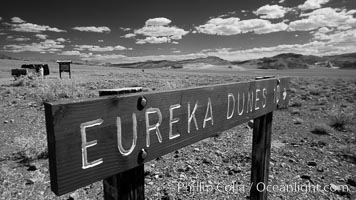
Sign to Eureka Dunes and Eureka Valley.
Location: Eureka Valley, Death Valley National Park, California
Image ID: 25389
Location: Eureka Valley, Death Valley National Park, California
Image ID: 25389

Panorama of the Racetrack at Death Valley.
Location: Racetrack Playa, Death Valley National Park, California
Image ID: 27686
Panorama dimensions: 2831 x 15932
Location: Racetrack Playa, Death Valley National Park, California
Image ID: 27686
Panorama dimensions: 2831 x 15932

Zabriskie Point sunrise, clouds blurred by long time exposure, Death Valley National Park, California.
Location: Zabriskie Point, Death Valley National Park, California
Image ID: 27655
Location: Zabriskie Point, Death Valley National Park, California
Image ID: 27655

Sunrise lights Telescope Peak as it rises over the salt flats of Badwater, Death Valley. At 11,049 feet, Telescope Peak is the highest peak in the Panamint Range as well as the highest point in Death Valley National Park. At 282 feet below sea level, Badwater is the lowest point in North America.
Location: Badwater, Death Valley National Park, California
Image ID: 20549
Location: Badwater, Death Valley National Park, California
Image ID: 20549

Devils Golf Course, California. Evaporated salt has formed into gnarled, complex crystalline shapes in on the salt pan of Death Valley National Park, one of the largest salt pans in the world. The shapes are constantly evolving as occasional floods submerge the salt concretions before receding and depositing more salt.
Location: Devils Golf Course, Death Valley National Park, California
Image ID: 15582
Location: Devils Golf Course, Death Valley National Park, California
Image ID: 15582

Salt polygons. After winter flooding, the salt on the Badwater Basin playa dries into geometric polygonal shapes.
Location: Badwater, Death Valley National Park, California
Image ID: 27635
Location: Badwater, Death Valley National Park, California
Image ID: 27635